Important tool updates - Learn more
- Learn
-
Articles
Read about influencer marketing
-
Growthnotes - Newsletter
Insights for the modern marketer
82% of marketers invest in content marketing. But let’s be real, producing consistently good content is no easy feat. And if you’re active on multiple platforms and channels, sooner or later, you’re likely to face content shortage.
That’s when content repurposing can help you win the game.
With a few smart edits, you can transform a single blog into social media posts, videos, Reels, and even a newsletter. Likewise, a video can become a blog, TikTok clip, or podcast. The possibilities are endless.
Simply put, content repurposing could be used by any smart marketer looking to make the most out of each content piece.
Content repurposing = multiplying one asset into many formats
Key numbers
Main benefits
Repurposing playbook
Best-practice workflow
Bottom line
Content repurposing involves taking one piece of content and transforming it into various content formats to reach a wider audience and reduce the effort required for content creation.
For example, a long-form blog post can become social media posts, an email newsletter, a podcast episode, or even drive the script of a short-form video on Instagram Reels. That reduces the need to create fresh content for every platform you’re marketing.
Content repurposing fits seamlessly into a well-rounded content marketing strategy. Also, there are so many tools available that can help you repurpose content into different formats.
There’s a reason why 94% of marketers repurpose content. It provides numerous advantages. Marketing managers, for instance, can optimize return on investment (ROI) by repurposing the same content and reducing production costs.
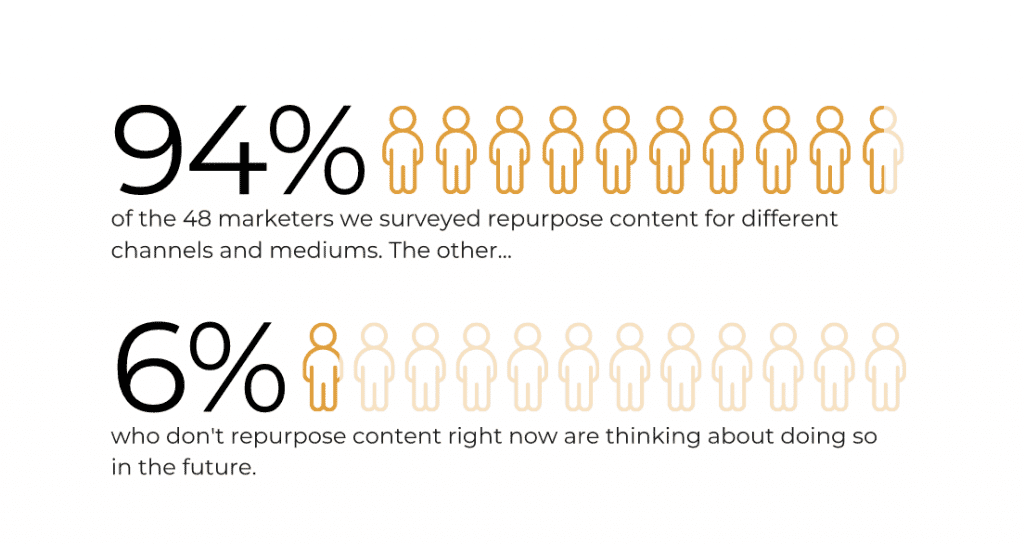
Let’s dive in:
Textual content, like blogs and ebooks, is a gold mine for repurposing. You can extract so many different formats of content from them with minimal effort. Here are some ideas:
Start with a data‑rich ebook or industry report and spin it into multiple blog articles. For example, a 10‑page white paper can become 3-4 long‑form blog posts.
According to Orbit Media, it takes about four hours to write a blog. However, it will take much less time if you already have an e-book or report to reference for the text and data.
If the eBook has different chapters, turn each chapter into a separate blog post. You can paraphrase the text or synthesize it with generative AI tools. Similarly, if you’ve published a report, take the key findings and turn them into a blog.
Use tools like Ahrefs for topic clustering and keyword optimization. That way, each blog targets unique search terms and supports your SEO efforts.
HubSpot regularly does this. They write blogs about their reports.
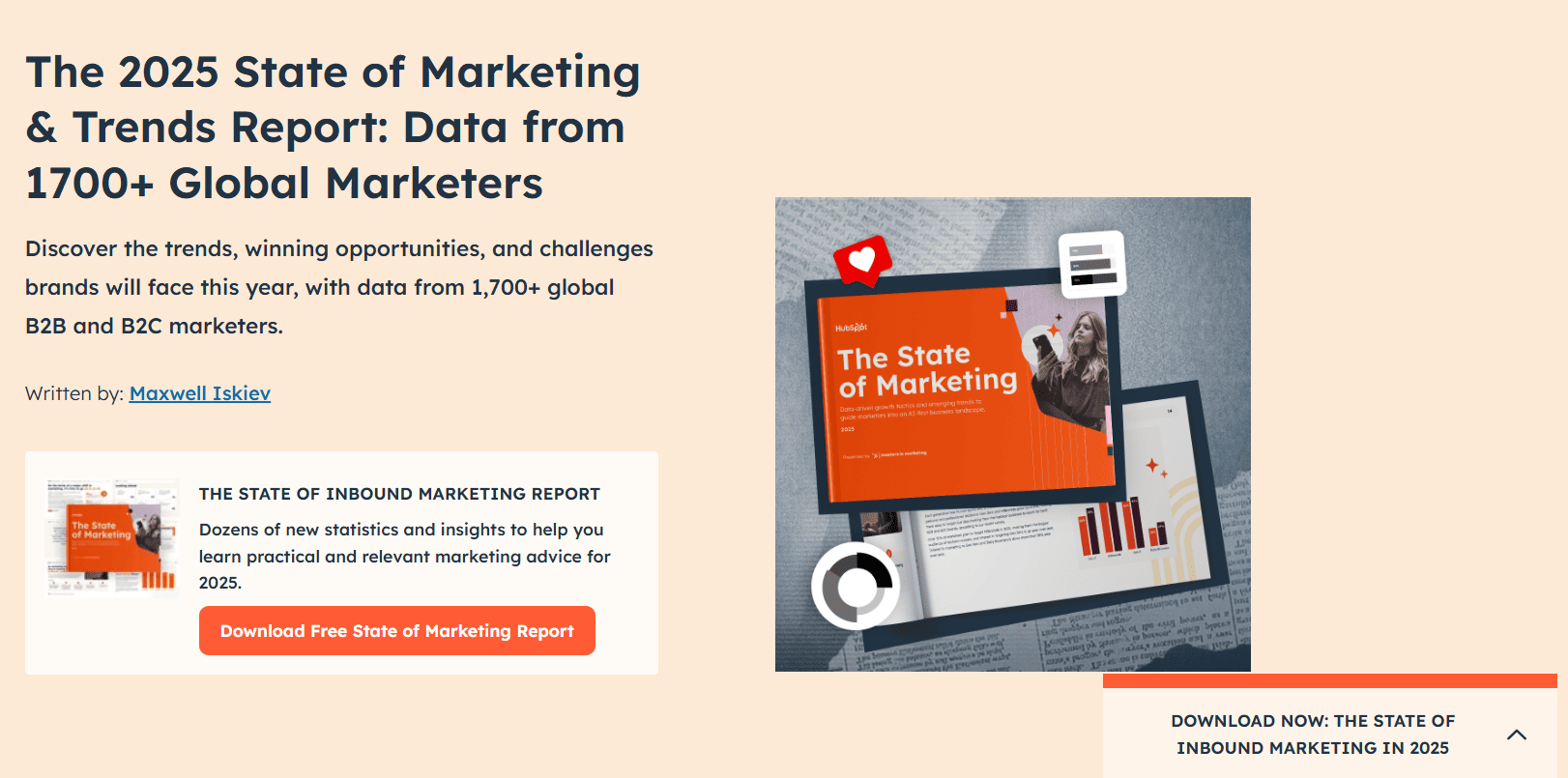
Pick compelling stats or quotes from a long‑form article or ebooks and turn them into social media posts or Instagram Carousel slides.
You can tweet the quote as it is, or better yet, make it a graphic. Tools like Canva help design static images or social posts easily.
Each piece of written content can be turned into multiple assets across platforms like X, Facebook, Instagram Threads, Instragram, and YouTube.
Here’s an example of how AWeber turned a blog about choosing a font into a social media post:
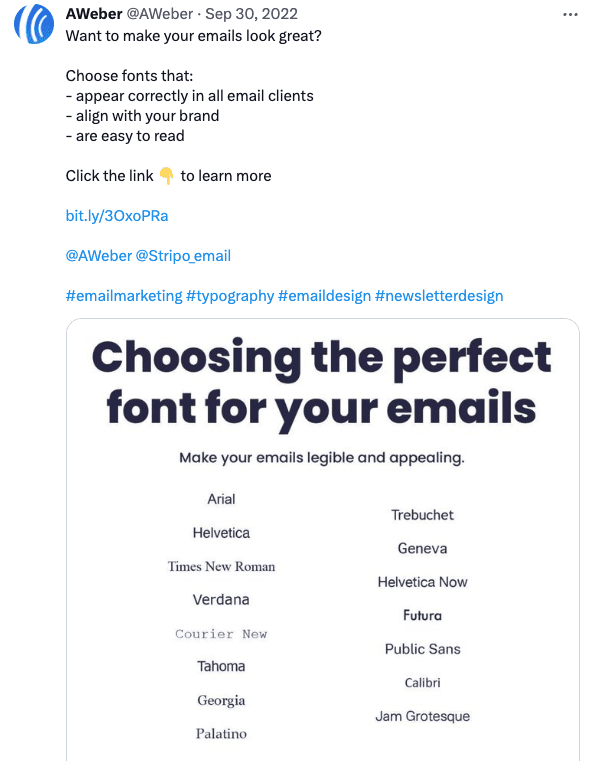
Repackage key points from a blog into an email newsletter. That can bring more traffic to the blog and increase engagement.
You can use email marketing tools like Mailchimp to segment your audience and send the newsletter to subscribers who are more likely to engage with your email and subsequently the written piece.
Similarly, you can use the content from your ebook or blog as answers in community forums like Quora or Reddit.

Transform blog content into short‑form videos like Instagram Reels or TikTok. For example, pull three tips from a long‑form article and demonstrate them visually.
While this takes some effort, AI tools like InShot make it easier by auto-generating captions and streamlining edits. For instance, you can use InShot to generate captions and edit clips. According to Content Marketing Institute, 32% of marketers now use AI tools to repurpose content.
These bite‑sized video clips can drive higher engagement than a text‑only adaptation while reaching a wider audience across social channels.
A third of all Internet activity is video-based. Perhaps that’s why 89% of businesses use video marketing. That’s just how big and important video content is.
Let’s see how you can repurpose video content into even more videos and other formats, too.
Long videos offer a goldmine for short clips. You can create several short-form videos, e.g, YouTube shorts, TikTok reels, and stories from them for social media. Alternatively, you can turn the entire video into a short one. You can use tools like Pictory to auto-generate 15–to 60-second highlight reels.
66% of consumers say they pay more attention to short-form videos. They’re a great way to get more eyes on your content.
That’s what our sister agency inBeat did with Hurom’s video content, turning longer videos into YT Shorts.
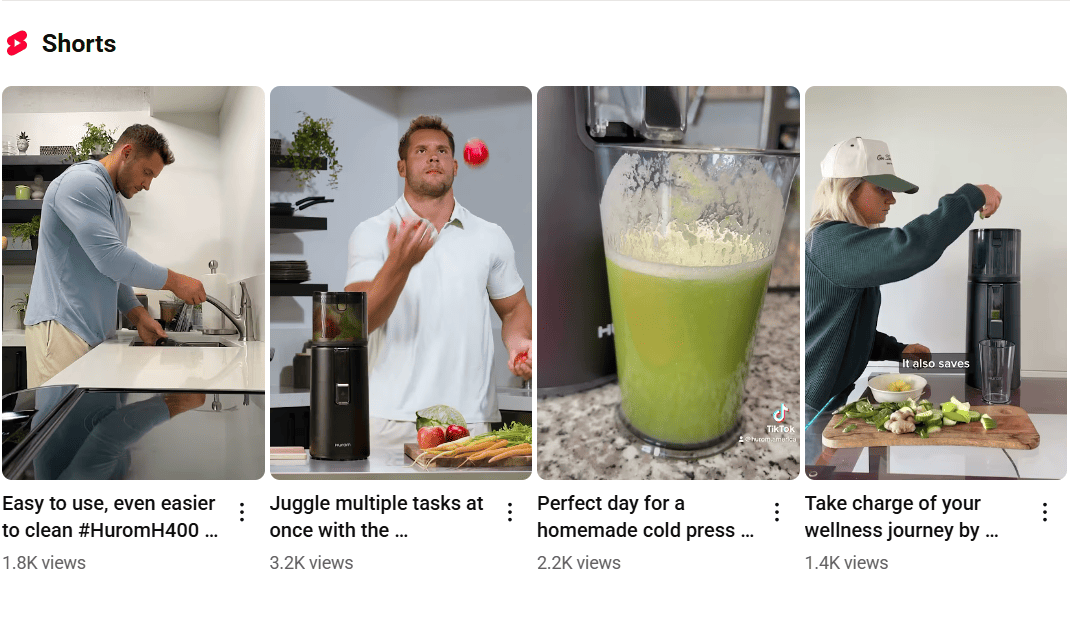
Extract the transcript of your video with Otter.ai, clean it up, and craft a long-form written content piece. This can support your SEO efforts by targeting keywords across search engines. Of course, this technique will only work with long-form video assets that provide enough content for a blog.
Similarly, you can also feature the video in the blog to improve its quality and cater to both audience preferences–those who like to read and those who like to watch.
If you can’t turn the entire video into a written piece, simply take snippets from it and feature them in an ebook or blog. This can be a quote from an interview or a finding from a study you mentioned in the video. In blogs, you can even feature a short clip of the video.
Use the audio track from your video to produce a podcast episode. With 82 % of people saying a video convinced them to buy, chances are your podcast can also have the same impact.
You can use a tool like VEED.io to extract the audio of a video, make it into a podcast, and publish on the mainstream podcast platforms. It’s easy, quick, and can help you push out your message to a wider audience.
This approach works best with interviews, conversational videos, and even documentary-style content.
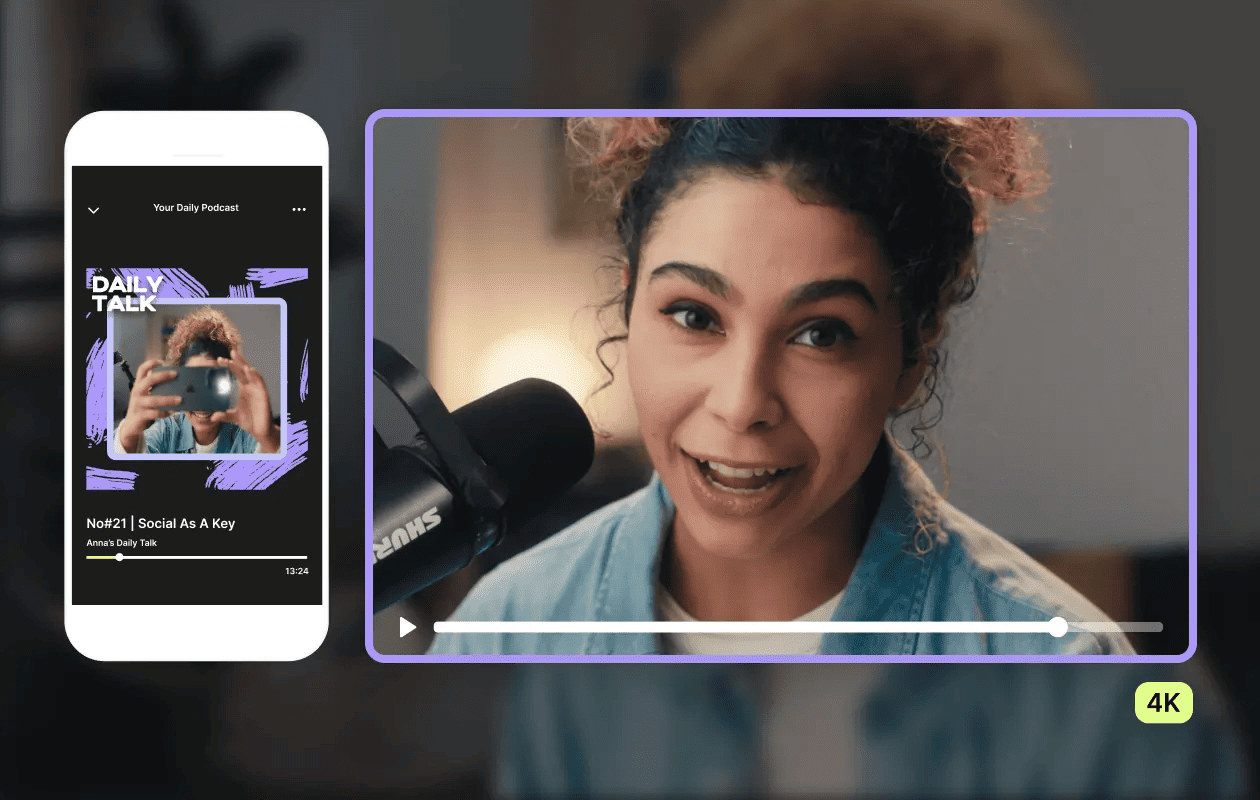
Grab shareable frames or visuals and turn them into an Instagram Carousel or static images. Tools like Canva make it easy to add captions or brand elements to those still shots. Static visuals can help drive more engagement alongside video content.
Make sure the still you use provides some value and context. For example, if you featured a statistic, you could post that as an image. Similarly, if the video covers a product, you can use stills from it to promote the product.
This is a fun one. Create branded GIFs from video snippets using tools like EZGIF or Canva.
You can use these in email newsletter content or blog content to boost engagement without heavy file sizes. You could also use the GIFs on social media as posts or even to engage with users in comments. Who knows, your GIF might even go viral.
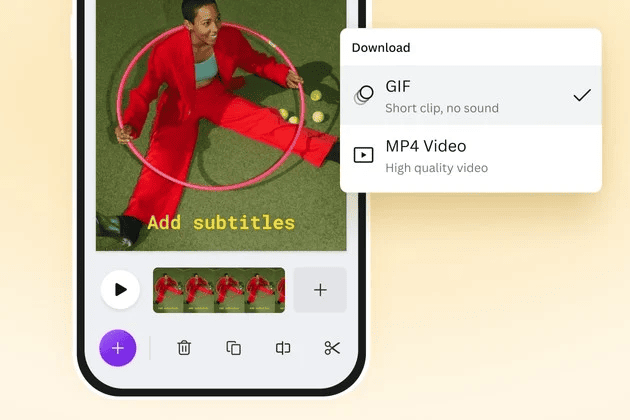
If your business has just hosted a webinar, you can even turn that into video content for YouTube. Repurpose webinar recordings with Zoom Webinars or StreamYard into long-form videos.
Webinars have an impressive 25% conversion rate. So, they’re a powerful option for marketing a product or service. Not to mention, if your webinar is engaging, it can even generate revenue through YouTube Ads.
See below how PivIT, a managed IT services provider, turned its webinar into a video series on YouTube.
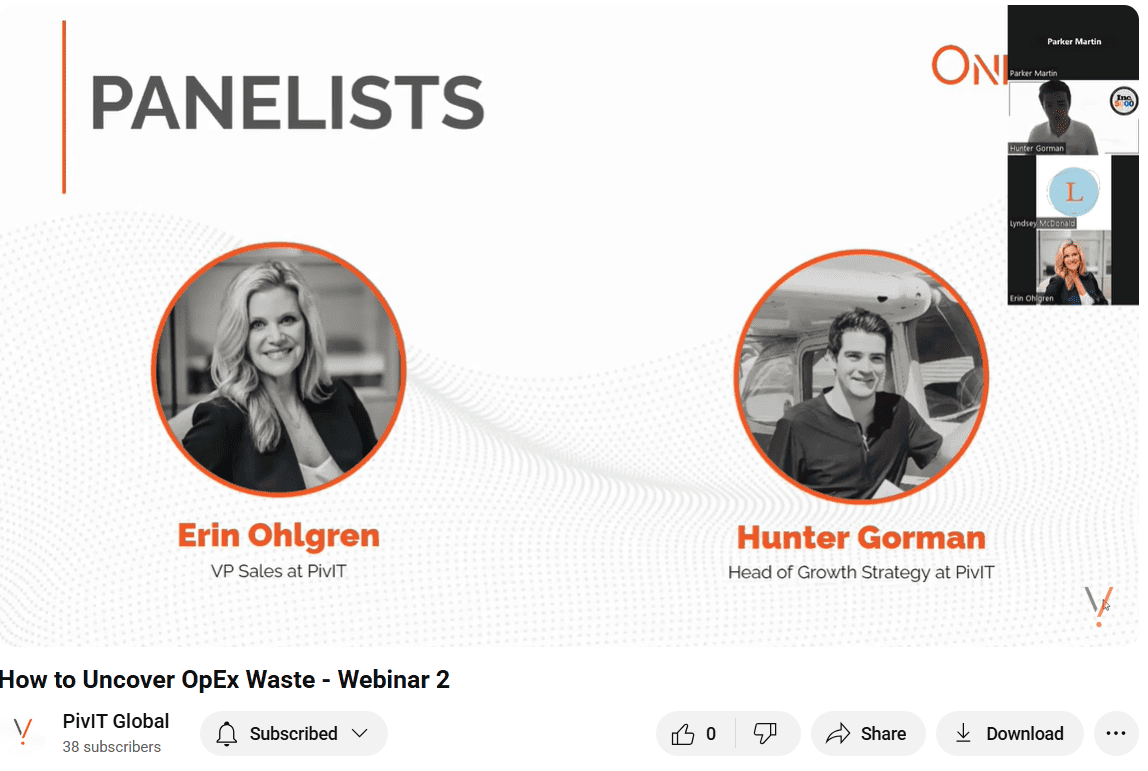
Slice 30 to 60 seconds of highlights from webinars and batch-produce short-form video assets. With Instagram Reels, TikTok, and YouTube Shorts combined market share, you can reach a larger audience across social platforms with minimal extra effort.
Identify important bits from the webinar and turn them into a short clip. For example, it could cover just one question and its answer from an expert. It could be a case study or an excerpt that a speaker shared.
Pick something that aligns with your brand and provides value.
For example, you see below how Descript’s “Karaoke Classic” layout was used to turn key webinar moments into a highlight reel, perfect for short-form video content across Reels, TikTok, or Shorts.
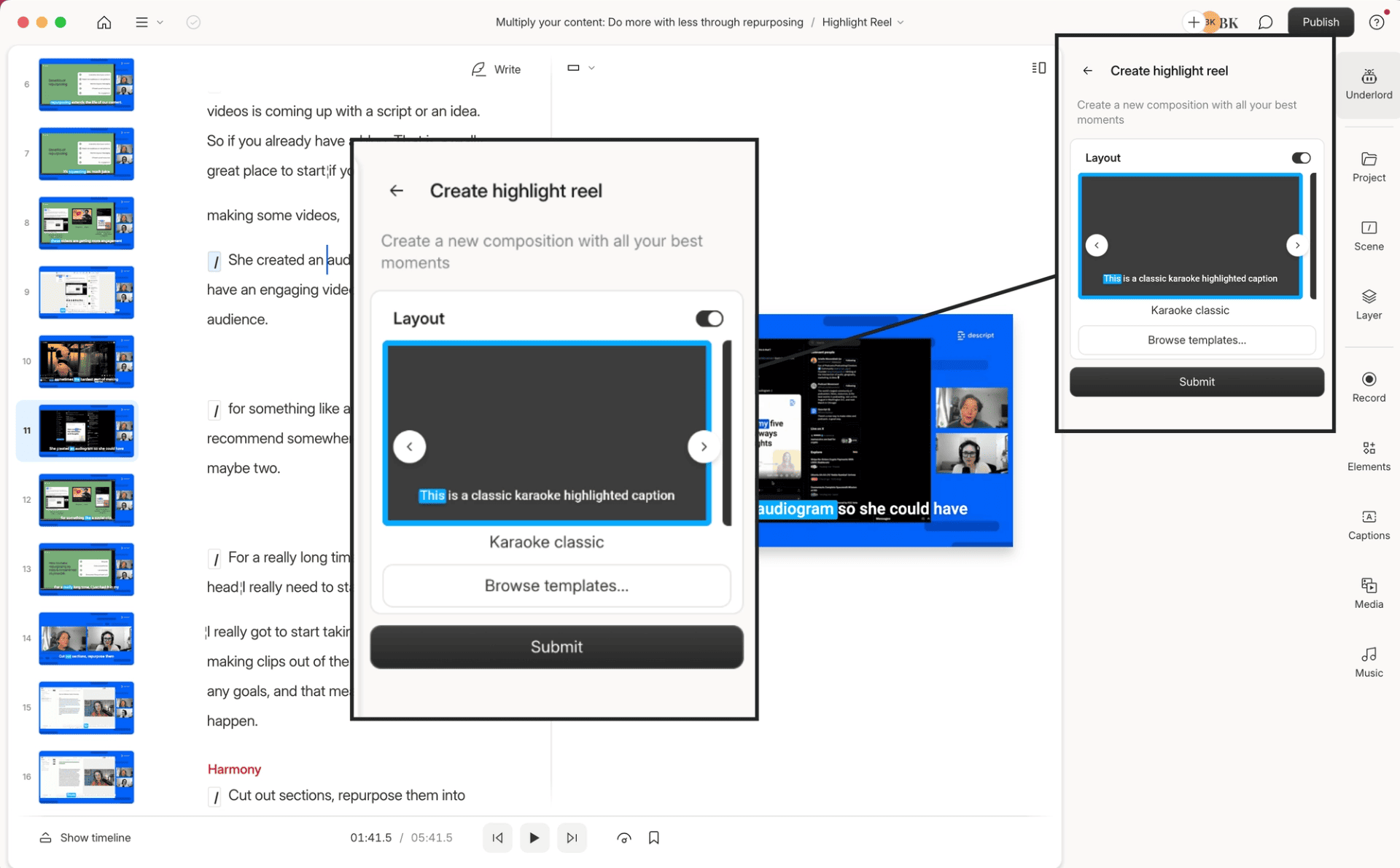
HubSpot reports that 48 % of social media marketers reuse similar or repurposed content across platforms rather than delivering completely fresh content each time.
Here’s how you can do the same:
Social media marketing is essential for most brands these days. That means being active on different social media platforms is a no-brainer.
That said, you don’t need to create original content for each social platform. Instead, fine-tune tone, hashtags, and format to match each audience. Adjusting hooks and structure delivers better results than copying posts word for word.
Social Champ and Buffer automate crossposting while letting you tweak captions or visuals per channel.
Look at the example below, where the same video has been optimized and posted on Instagram, TikTok, and YouTube.
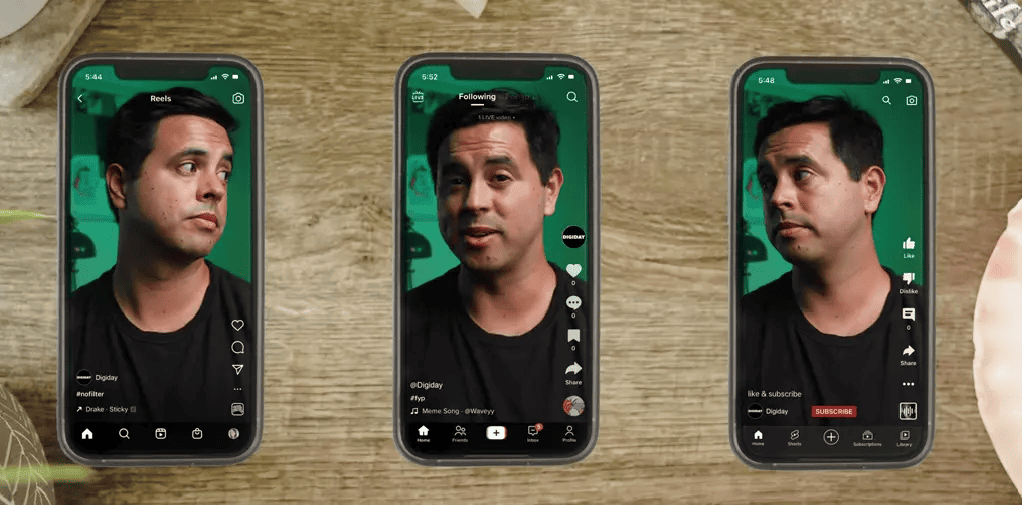
Expand a high-performing thread or X post into visual assets like Instagram Carousel slides, story, or a Reel. You can use Canva’s Instagram templates or InShot to animate slides into motivational Reels or TikToks celebrating your original post.
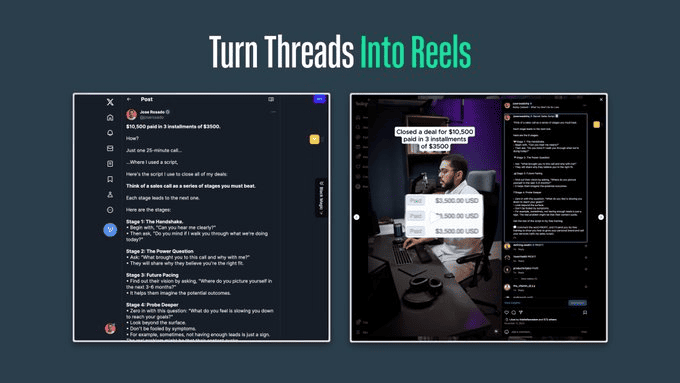
Group related short-form videos on a theme, like product reviews or tips, into a longer YouTube video.
Instagram, TikTok, and Threads each deliver strong engagement, but combining clips into one piece builds a content library for YouTube and supports your content marketing strategy (if YouTube is a part of it).
Use Descript to transcribe short clips, reorder ideas, and export a polished long-form video that fits search demand. Again, it will drive engagement and even bring in some revenue.
Save or download live video streams and share them across your social channels. After a LinkedIn Live or Instagram Live event, upload trimmed versions to YouTube, share 60‑second clips on Reels or X, or embed them in your blog or email newsletter.
Sprout Social's report revealed that brands publish around 9.5 social media posts per day. That’s a lot of posts to catch up with. So, if you’re not already using your livestreams as content, you should start. Reusing livestreams multiplies that output without extra creation effort.
Some more ways to win with content repurposing are:
Turn content pieces into user-generated or influencer-generated assets. A study by Tomoson found brands earn an average of $6.50 for every $1 spent on influencer content, while top performers can see up to $20 per $1.
For example, share your blog post on Threads or X and ask industry experts to add their take. Or send the content to micro-influencers to create short-form videos. You can then reuse these videos in social posts, blog embeds, or email newsletters.
This helps expand your audience, improve engagement, and strengthen your content marketing strategy with minimal extra effort.
Explore our guide on finding influencers.
You can build both evergreen pieces and long-form blog content using existing audio assets. Use AI transcription tools like Otter.ai or Fireflies.ai to transcribe the audio of a podcast. Then, polish the transcript into a long-form article. You’ll create new written content without actually creating content from scratch.
The blog can be a direct transcription of the podcast conversation or a summary of the key insights from it. Either way, it will help boost SEO.
Add video assets to your website or landing pages as value-rich content formats. Embedding influencer or user-generated videos increases conversions and aids content syndication.
A single video embedded in a landing page can increase time on page by 80-86%, enrich content formats, and feed into your visual content library.
This approach can work well for your broader digital marketing strategy by appealing to varied audience segments and different content preferences while reinforcing marketing goals.
For example, Mindbloom embeds calming, value-driven video content on its landing page to create a more immersive and effective user experience.

Effective content repurposing strategies start with selecting high-performing content and adapting it for varied content formats.
Here’s a scenario with a blog as the seed content:
Begin with tools like Google Analytics to audit blog content and identify top-performing posts. Then, use Surfer SEO to target additional keywords before converting that content into micro-content or social posts. This aligns with how a structured content creation workflow can improve SEO efforts and content ROI.
Next, match repurposed assets to target audience segments. Turn a long-form article or webinar into bite-sized Instagram Reel or YouTube Shorts clips that suit the platform’s consumption habits.
Use repurposing tools to save effort and maintain quality. Descript and Kapwing speed up the transformation of video into audio podcasts, GIFs, or static visuals while keeping brand voice consistent.
Always measure performance after distributing content across channels: track engagement metrics like CTR, video views, audio listens, search position, and social posts reach. Semrush found that 42% of marketers saw successful campaigns after updating or repurposing old content. That confirms repurposing works in practice, not just theory.
Finally, reinforce content with a clear plan across the awareness, consideration, and decision stages. Use the content strategically, where it makes sense and where it can have the maximum impact. Align your repurposing efforts with your content marketing strategy.
“Repurposing isn't just about taking one thing and turning it into a million, but making very strategic choices about what is shared where and framing it in the best way possible for that channel,” says Tommy Walker of The Content Studio.
Brands are under constant pressure to publish content for marketing, engagement, and SEO. But when time or ideas run low, repurposing can be a lifesaver. It’s cost-effective, time-conserving, and even creative to some extent.
With smart repurposing, a single piece of content can serve multiple goals, improve SEO through a blog, drive awareness with a video, and generate leads via social posts.
For best results, consider partnering with a content creation agency that specializes in building assets designed for multi-platform reuse.
Check out the best content creation agencies!
Absolutely. Brands regularly turn long‑form blog or webinar content into Instagram Carousel slides, Reels, or Threads-style posts. For example, you can make Instagram posts using quotes or statistics from a blog or an ebook. You can turn a longer YouTube video into a reel or story. Using Instagram for publishing content also aligns with audience preferences for visual content.
Pull compelling statistics or quotes and turn them into social media posts or images in Canva. You can then export your blog transcript into a script for a video or podcast using Otter.ai.
You can repurpose video into different formats. Extract the transcript, then craft a long‑form SEO blog post. Similarly, extract just the audio of the video and turn it into a podcast, especially if it’s an interview.
For social media content, split the video into short‑form clips for replacements like Reels, TikTok, or Shorts. GIFs are another low-effort, high-impact format you can create with GIPHY or Photoshop.
Audit your content library using analytics tools like Google Analytics or Ahrefs. Choose posts with high performance and then adapt them across different formats, like email newsletter segments, static visuals, short‑form videos, ebooks, etc. Track engagement metrics across each channel to measure the ROI of each content asset and identify which formats are most successful.
One real‑world example of content repurposing comes from Stingray Writing, a digital marketing provider. Brittany Wren, founder, turned a single 45‑minute executive interview into a feature in local publications, multiple social posts, blog, and email newsletter mentions, and radio guest spots.
The content repurposing model (also called content recycling) is a model of content marketing where you take a seed content and transform it into different formats. With this model, you produce long-form written and video content that can ultimately be repurposed into many different pieces.
The process of repurposing content depends on the type of content you want to repurpose. For example, you can start with data‑rich long‑form content, like a blog, report, or webinar, and use transcription tools to pull quotes and audio. Convert those elements into bite‑sized visuals in Canva, short‑form video using InShot, or reorder into a newsletter in Mailchimp.
Choose a blog post that performs well in Google Analytics. Highlight key stats, for example, “85 % of marketers reuse content,” then create static visuals or quote slides in Canva. Write an X (Tweet) or Instagram Thread selecting the same insights. You can do the same with quotes, turning actual sentences from the blog author into nicely designed graphics for Instagram, Facebook, LinkedIn, or Pinterest.